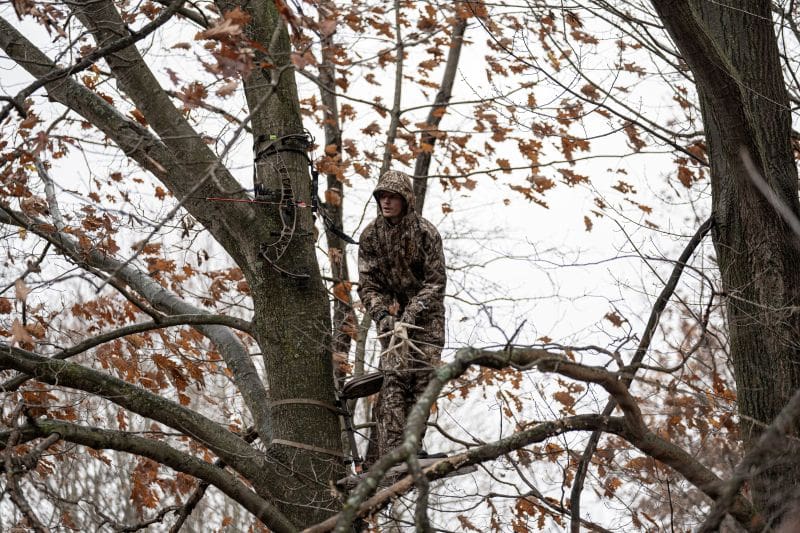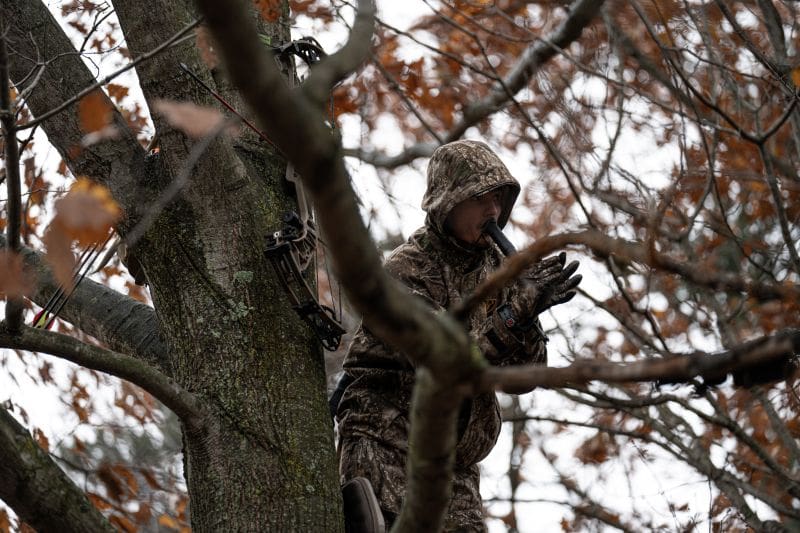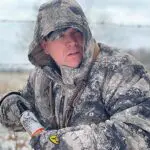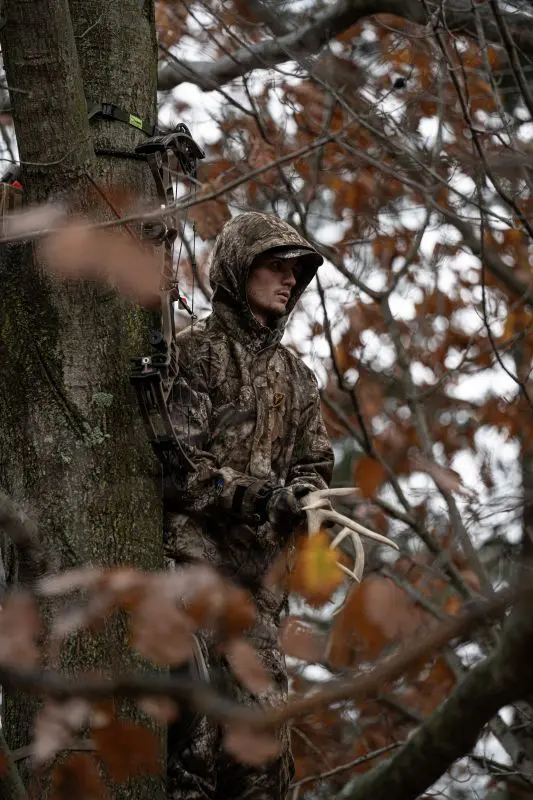When November arrives, the woods come alive with the sounds of love struck bucks searching for receptive does. It’s the magical time hunters wait for all year, the rut. And for those who know how to “talk the talk,” it’s also the best time to call deer within bow or rifle range. Whether it’s a subtle grunt that draws in a curious buck or the crash of antlers that triggers a territorial charge, mastering deer vocalizations and rattling can turn a quiet morning into one you’ll never forget.
During my home state’s November firearms season last year, I witnessed firsthand just how powerful grunting can be when it comes to drawing in bucks. I was sitting quietly in my tree saddle when a loud grunt broke the stillness. From across the open field and up the wooded hillside, I could hear the echo of a buck grunting several times. Not long after, another buck appeared on the opposite end of the field. He stood at the fence line, scanning the area to see who was making those deep, throaty sounds. It wasn’t my call he was responding to, but it was the first time I’d ever watched a buck react to a natural grunt in real time.

Moments later, a more mature buck came from the same direction as the original sounds. Whether they were searching for each other or chasing the same doe, I couldn’t tell. Both disappeared back into the timber, and I went back to waiting. About twenty minutes later, another deep grunt rolled out from the ravine below me. Seconds after, a doe burst from the bottom with a mature buck right on her tail. He trailed her straight beneath my setup, giving me a perfect close-range shot. After the hit, the buck ran back into the ravine, and soon, a smaller buck trotted through the same spot.
In just thirty minutes, I’d seen four different bucks, all drawn in by the unmistakable sounds of the rut. That experience proved why so many hunters never head into the November woods without a grunt call or rattling antlers within reach.
Understanding the Rut’s Language
Just like turkeys and elk, whitetails have their own communication system. During the rut, bucks use vocalizations and body language to assert dominance, find does, and challenge other bucks. Like the turkey or elk hunter again, those who know how to mimic their sounds tap directly into the natural curiosity and aggressive rut instincts.
Grunts are the most common and fundamental part of deer vocabulary during the rut. A short, low grunt is usually a contact or tending sound made by a buck near a doe. A deeper, drawn out grunt can imitate an aggressive, dominant buck. Learning to vary pitch, volume, and cadence depending on the situation makes all the difference.
Bleats often made by does can also be highly effective during the peak rut. A simple doe bleat mimics a receptive female and can attract bucks from downwind. Using a can style call, such as the famous Primos can or a mouth blown bleat tube, makes these sounds easily, especially when combined with light grunting.
Then there’s the snort wheeze, a bold, high-stakes call of dominance. It’s the white tailed deer’s way of issuing a face-to-face challenge. When used sparingly, it can provoke an immediate reaction from mature bucks looking for a fight. I remember the first time I heard a snort wheeze in the wild. I thought to myself, that buck has a cold and is trying to sneeze. It’s not the same as a deer blowing when they smell you; it’s literally a wheezing sound coming from a buck’s nose. I’ve used the snort wheeze to attract bucks more than I have used a familiar grunt. When used at the right moment, this sound is magical for a deer hunter.
I strongly encourage hunters to listen and study these different whitetail sounds. Listen to them online, try to mimic them with your preferred call, then practice, practice, practice just like a turkey caller does before the spring hunting season.

The Art of Rattling
Rattling antlers together mimics the sound of two bucks sparring or fighting over a doe, which naturally occurs during the pre-rut and rut. When done correctly, it’s one of the most exciting and effective ways to attract a buck on a string.
During the pre-rut, light, short rattling sessions are most effective, as bucks are primarily testing each other rather than engaging in physical combat. By mid to late rut, don’t hesitate to get more aggressive. Crash the antlers, grind them together, and even incorporate ground noise like rattling, kicking leaves, thumping the ground, or add a grunt or two to create the illusion of a fierce brawl.
The key is realism. Bucks can tell the difference between a hunter clanking plastic and two real deer. Use real antlers or a high-quality synthetic rattling bag that produces authentic sounds. Again, be sure to practice making the sounds for several weeks before hunting season.
Setting the Stage
Location and timing are just as important as your call quality. Rattling in open hardwoods, along transition lines, or near known bedding areas can be deadly. Early morning and late afternoon are typically prime times when bucks are active. Twenty or thirty minutes after first legal shooting light has always been my favorite time to call and rattle, and it’s when I’ve encountered the highest response. Timing is important, but also be mindful of the wind when calling. Bucks will almost always try to circle downwind of the sound before committing, so position yourself where you can intercept them without being scented. This will most definitely boost your success rate.

Knowing When to Call and When Not To
One of the biggest mistakes hunters make is overcalling. Whitetails have a keen sense of hearing, and constant noise can make them suspicious. Call sparingly, then sit tight. If you think a buck heard you, resist the urge to keep calling. Let curiosity and dominance take over. Calling too often can cause a hunter to call too loudly. When a buck is nearby because he’s responding to your call, and you rattle off another battle sequence, you will scare him out of the country. Be patient, give them time to respond, and make them curious.
When you don’t get a response, adjust your approach. If a buck hangs up at a distance, tone down the intensity; sometimes, a soft grunt or doe bleat is enough to coax him in. If he’s closing the distance quickly, stay quiet and get ready. Be willing to modify your tactics and stay versatile, just as you would by switching your stand or tree saddle to improve your position. Maintain the same mindset when using your grunt call and rattling.
Bringing It All Together
The best deer callers aren’t just making loud noises in the woods; they’re calling with a mission. I’ve seen some hunters, and I’ve been guilty myself of calling out of boredom. Instead, call with a purpose and do so at the right moments. When a hunter learns when to grunt softly, when to rattle aggressively, and when to let silence speak for itself, they can turn every call into part of a conversation that taps into a buck’s instincts and emotions.
The rut only lasts a few short weeks, but its opportunities are unmatched. This season, take the time to master the art of calling and rattling. When the woods echo with your challenge and a heavy racked buck slips in, you’ll know you’ve talked the talk.

